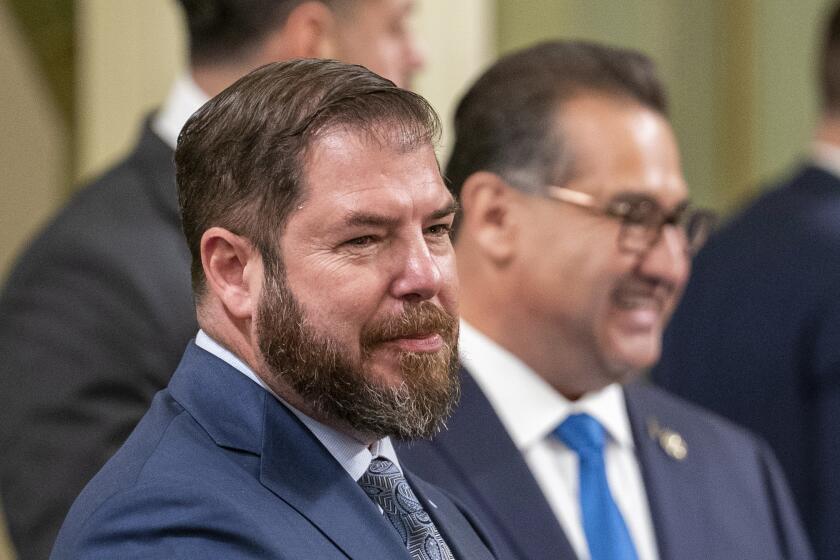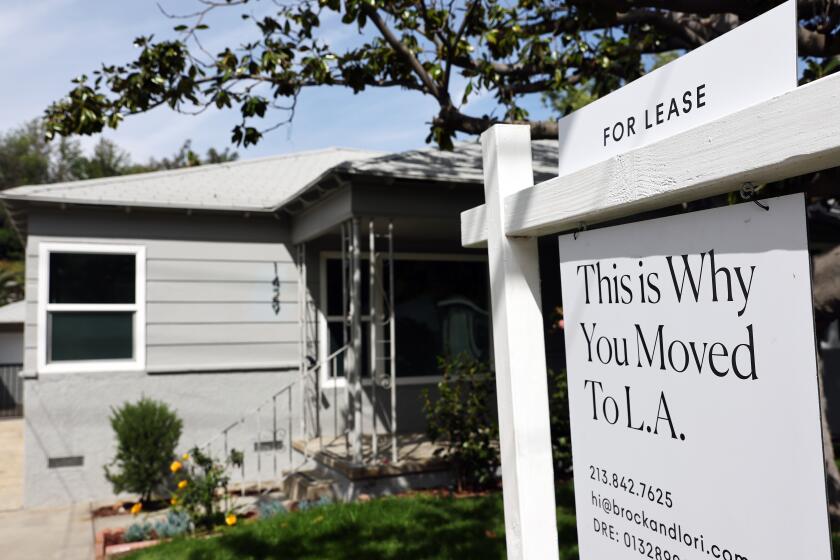Need help with missed mortgage payments in California? Apply soon: Money is running out

Did a pandemic-related financial crunch leave you with mortgage troubles? The state may be able to help, but not for much longer.
The California Mortgage Relief Program offers up to $80,000 to low- and moderate-income homeowners hurt financially by the pandemic who missed mortgage payments, deferred some monthly installments or have overdue property taxes. Having awarded more than $847 million of its $1-billion budget, however, the program could run out of money soon, state officials say.
So far, the program has helped more than 34,600 homeowners across the state, most of whom have incomes at or below their county’s median. The aid isn’t a loan, but a payment made on the borrowers’ behalf to clear their mortgage or property-tax debt so they can keep their home.
“When you look at who received those funds, it’s been a real success,” said Rebecca Franklin, president of the California Housing Finance Agency’s Homeowner Relief Corporation. By using about 75% of the funds to help families earning no more than their county’s median income, and 55% of the money in communities that are historically disadvantaged, “we really were successful at getting the money to those populations who really were hit harder by the pandemic,” she said.
“We weren’t trying to help everybody. We were trying to focus the funds on those who needed it the most” — and the ones who couldn’t afford to become homeowners again if they were foreclosed on, considering the state’s current housing market, Franklin said.
New legislation could help undocumented immigrants become eligible for a loan program to purchase a home.
The 2021 American Rescue Plan Act put almost $10 billion into a Homeowners Assistance Fund to help prevent low- and moderate-income Americans suffering pandemic-related financial hardships from losing their homes. California was one of the first states to use HAF dollars to launch a mortgage relief program, said Stacey Tutt, homeowner assistance fund coordinator and senior staff attorney at the National Housing Law Project.
During the Great Recession, Tutt said, distressed homeowners often avoided foreclosures through loan modifications. But during the pandemic, rising interest rates and property values left many homeowners unable to obtain modifications that reduced their monthly payments.
The Homeowners Assistance Fund was “essential to keeping people in their homes,” she said, adding, “I can’t imagine what our housing market would look like right now without these HAF dollars getting out the door.”
“As someone who has watched HAF be implemented across the country … I do think California did an amazing job,” Tutt said. Not only was California one of the first states to mortgage relief dollars out to homeowners, she said, it also expanded the program to more types of relief as needs evolved.
State assistance is available to qualified homeowners who’ve missed at least two mortgage payments by Feb. 1 and are still in arrears, or who’ve missed at least one property tax payment by Feb. 1. Various restrictions apply, but the main ones are that aid is available only for owner-occupied homes and that an applicant’s total household income must be no more than 150% of the area median income. In Los Angeles County, that’s $132,450 for an individual and $189,150 for a family of four.
Tenants should be aware of their rights and the local resources they can turn to now that many of the renter protections have expired.
Even if you do not qualify for a grant — your mortgage may be too large, for example — the state program has provided grants to legal service organizations and housing counselors to help you navigate your way to a solution, Franklin and Tutt said.
Here are more details on who’s eligible for a grant, how to apply and what’s covered.
Who qualifies for relief?
Under federal law, households earning up to 150% of the median income in their county who suffered a pandemic-related financial hardship are eligible for up to $80,000 in relief. The limit rises as the number of people in your household increases; to find the limit for your household, consult the calculator on the program’s website.
The program defines a financial hardship as either reduced income or increased living expenses stemming from the COVID-19 pandemic. According to its website, qualifying expenses include “medical expenses, more people living in the household or costs for utility services.”
The L.A. City Council adopted an ordinance that protects tenants awaiting emergency rental aid from being evicted while the funds are processed.
There are a few more limitations, however:
- The home in question must be your principal residence.
- You may own only one property, although it may have up to four units on it.
- Your mortgage may not be more than $80,000 in arrears. The program can’t make partial payments on your debt.
- If you’ve already paid off your mortgage or tax debt, you can’t recoup that money by applying for state aid.
- You will not qualify if your mortgage is a “jumbo” loan bigger than the limits set by Fannie Mae and Freddie Mac.
- You can’t obtain the state’s help if you have more than enough cash and assets (other than retirement savings) to cover your mortgage or tax debt yourself.
- Your mortgage servicer must be participating in the program.
What kinds of help are available?
The program will cover past-due mortgage payments and property tax debt for eligible households, but it doesn’t stop there. Funds also can be used for:
A second shot of relief. The mortgage relief program was originally seen as one-time-only assistance. Now, however, California homeowners who’ve already received help can apply for more if they have missed more payments and remain eligible. No household may collect more than $80,000 over the course of the program.
Reverse mortgages. Homeowners with reverse mortgages can apply for help with missed property tax or home insurance payments.
Partial claim second mortgages and deferrals. This applies to certain borrowers who fell behind on loans backed by the Federal Housing Administration, the U.S. Department of Agriculture or the Department of Veterans Affairs. Rather than demanding larger payments to cover the past-due amount, the agencies encouraged lenders to split off the past-due portion into a second, interest-free mortgage called a partial claim. That way, a borrower could stay current by paying just their usual monthly payment.
Mortgage interest rates have fallen more than a percentage point since October. The drop relieves prospective buyers, but experts say rates are likely to stay high.
The partial claim second mortgage could be ignored until the house was sold, the mortgage was refinanced or the first mortgage was paid off, at which point the partial claim would have to be paid in full. In the meantime, it’s a real debt that affects the borrower’s ability to obtain credit.
Similarly, some lenders offered deferrals that bundled the missed payments into a sum that was tacked on to the end of the loan. Borrowers wouldn’t face higher monthly payments, but they would have to pay off the deferred amount (a “balloon payment”) when they refinanced, sold their house or reached the end of their loan.
The mortgage relief program offers up to $80,000 to pay all or part of a COVID-related partial claim or deferral received during or after January 2020.
How do you apply?
Applications are available only online at camortgagerelief.org. For help filling one out, you can call the program’s contact center at (888) 840-2594, where assistance is available in English and Spanish.
If you don’t have access to the internet or a computer, you can ask a housing counselor to assist you. For help finding a counselor certified by the federal Department of Housing and Urban Development, call (800) 569-4287. You may also get help from the company servicing your mortgage.
The online application process starts with questions to determine your eligibility. If you meet the state’s criteria, you can complete an application for funds. Here’s where you will need some paperwork to establish how much you earn and how much you owe.
Cities in the Los Angeles area are seeing lower rents as Orange County prices hold firm or even increase. Experts are calling for more tenant protections.
According to the program’s website, among the documents you will need to provide are a mortgage statement, bank statements, utility bills and records that show the income earned by every adult in your household, such as pay stubs, tax returns or a statement of unemployment benefits. If you don’t have access to a digital scanner, you can take pictures of your documents with your phone and upload the images.
You’ll also need to provide a California ID or a Social Security number.
The site provides links to the application in English, Spanish, Chinese, Korean, Vietnamese and Tagalog.
Who has received aid?
According to statistics kept by the program, about three-fourths of the money has been used to help households at or below the area median income. In fact, nearly half of the funding has gone to families whose incomes are no more than 30% of the area median, which in L.A. County would be about $26,500 for a single person or $37,830 for a family of four.
About 52% of the aid has gone to Latino and Black Californians, who together make up about 29% of the state’s homeowners.
The money will be awarded on a first-come, first-served basis, with two important caveats: According to the California Housing Finance Agency, 60% of the aid must go to households making no more than the area median income, and 40% must go to “socially disadvantaged homeowners.” Those are residents of the neighborhoods most at risk of foreclosure, based on the Owner Vulnerability Index developed by UCLA’s Center for Neighborhood Knowledge.












